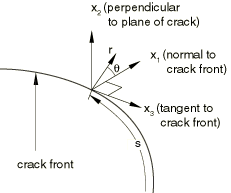J-integral in two dimensions
In the context of quasi-static analysis the J-integral is defined in two dimensions as
where is a contour beginning on the bottom crack surface and ending on the top surface, as shown in Figure 1; the limit indicates that shrinks onto the crack tip; is a unit vector in the virtual crack extension direction; and is the outward normal to . is given by
For elastic material behavior W is the elastic strain energy; for elastic-plastic or elastic-viscoplastic material behavior W is defined as the elastic strain energy density plus the plastic dissipation, thus representing the strain energy in an “equivalent elastic material.” This implies that the J-integral calculation is suitable only for monotonic loading of elastic-plastic materials.

Following Shih et al. (1986), we rewrite Equation 1 in the form
where is a sufficiently smooth weighting function within the region enclosed by the closed contour and has the value on and on C; and is the outward normal to the domain enclosed by the closed contour, as shown in Figure 2. on ; and is the surface traction on the crack surfaces and .

Using the divergence theorem, we convert the closed contour integral into the domain integral
where A is the domain enclosed by the closed contour . It is worth noting that the domain A includes the crack-tip region as .
If equilibrium is satisfied and W is a function of the mechanical strain—i.e., —we have
where is the body force per unit volume and is the thermal strain. Substituting the above two equations into Equation 3 gives
To evaluate these integrals, Abaqus defines the domain in terms of rings of elements surrounding the crack tip. Different “contours” (domains) are created. The first contour consists of those elements directly connected to crack-tip nodes. The next contour consists of the ring of elements that share nodes with the elements in the first contour as well as the elements in the first contour. Each subsequent contour is defined by adding the next ring of elements that share nodes with the elements in the previous contour. is chosen to have a magnitude of zero at the nodes on the outside of the contour and to be one (in the crack direction) at all nodes inside the contour except for the midside nodes (if they exist) in the outer ring of elements. These midside nodes are assigned a value between zero and one according to the position of the node on the side of the element.

